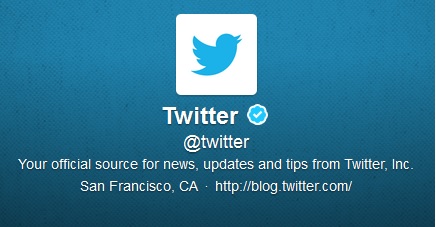
Exception to the rule: when researching Twitter, you’re more than welcome to visit Twitter.com.
Introduction
Let’s say you’ve never heard of a company before, but want to learn more. You land on the company’s home page and need to answer some rudimentary questions:
- What does the company do?
- Where are they headquartered?
- What’s been going on lately?
You’d typically look for pages such as “Contact,” “About Us,” and “News” and perhaps you’d get some answers. Lately, I skip those pages and simply look for the Twitter icon (which 90+% of companies have). Visiting their Twitter profile tells me everything I need to know.
Let’s consider ten reasons to skip the web site in favor of a company’s Twitter profile.
1) Character limit increases clarity.
What does a company do? On an “About Us” page, they have an unlimited amount of space. The description on your Twitter profile has a limit of 160 characters. As with tweets, the economy of characters forces you to be simple and efficient. The description on a company’s Twitter profile is far better than the text on their “About Us” page.
2) A picture is worth a thousand words.

Photo source: the profile page of @VirginAmerica.
Twitter’s profile page displays six of the company’s most recently posted photos (in thumbnail size). These images helps paint a picture of the company and are more personal (i.e. “real”) compared to what they might post on their web site.
3) Find out where they’re based (right away).
I like to know where a company is based. On some web sites, you’ll get a “Contact Us” page, but no physical address. You might have to navigate to the Press Releases page and find out where the releases were issued from. It’s all too hard. The Twitter profile asks for “Location” and most companies list their headquarters’ location. Just what I need.
4) Find related Twitter accounts.

Photo source: the profile page of @ConstantContact.
Companies will use separate Twitter accounts for assorted functions (e.g. customer support). Sometimes, knowing about these additional accounts can be useful.
5) Now what do you REALLY do?

Companies that sell complex products can lose us when they begin to describe just what it is they do. The first instance of jargon brings with it the potential for confusion. The description (above) by McAfee doesn’t go into detail on products or solutions. But it’s an elegant and simple statement that we can all understand.
6) What have you been up to lately?
Read a company’s five most recent tweets. More often than not, you’ll have your answer. Here’s an example of a tweet from @Bunchball:
Caitlin Donaldson, our Data Analyst, recently joined the world of #gamification. Here’s what she has learned so far: http://t.co/VFFUvLo5KO
— bunchball (@Bunchball) March 21, 2013
7) What’s your “social persona”?
A company’s Twitter profile can tell a lot about their approach to social. Consider these questions you can ask:
- Do they follow back?
- Do they retweet others?
- Do they interact with other users via “@ mentions”?
- Do they post photos?
- Do they share others’ content, in addition to their own?
8) View creative images you won’t see on the web site.
I love seeing the creativity used by some companies in their Twitter profiles. When Twitter launched header images (to complement your photo), it unleashed a torrent of creativity. Check out the image combination from @Ford:

9) What’s your personality and culture like?
A company’s tweets tell us about their employees and their culture. In addition, the Twitter account embodies an answer to the question, “hey company, what’s on your mind?” And that’s something social media provides that a web site cannot.
10) Are you following me?
OK, I had to add this one as a form of “Twitter vanity.” If you’re checking out a company and they’re already following you, make sure you follow them back (if you’re not already doing so)!
Note: This post was originally published at It’s All Virtual.
(144)






